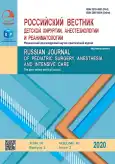Фаллопластика по De Castro при агенезии полового члена
- Авторы: Каганцов И.М.1,2, Дубров В.И.3, Де Кастро Р.4
-
Учреждения:
- Федеральное государственное бюджетное образовательное учреждение высшего образования «Сыктывкарский государственный университет имени Питирима Сорокина»
- Государственное учреждение здравоохранения «Республиканская детская клиническая больница
- Учреждение здравоохранения «2-я городская клиническая детская больница»
- Центр Хирургии Больницы Петруччани, Лечче, Италия
- Выпуск: Том 10, № 2 (2020)
- Страницы: 183-191
- Раздел: Клинические случаи
- URL: https://journals.rcsi.science/2219-4061/article/view/122908
- DOI: https://doi.org/10.17816/psaic659
- ID: 122908
Цитировать
Полный текст
Аннотация
Введение. Агенезия полового члена (афаллия) является чрезвычайно редкой врожденной аномалией. До настоящего времени во всем мире описано около 100 случаев данного порока. Частота встречаемости данного врожденного порока оценивается как 1 случай на 20–30 млн рождений. Одна из наиболее используемых фаллопластик сегодня — это методика, предложенная Роберто де Кастро (Roberto de Castro) в 2007 г. В данной статье мы представляем клинический случай афаллии у мальчика, которому выполнена фаллопластика.
Материалы и методы. Новорожденный мальчик с афаллией, в сочетании с аномалией развития обеих почек. При рождении у ребенка затрудненное мочеиспускание через свищ на границе с анусом. На 5-е сутки жизни ребенка проведена меатотомия и дилатация уретры. На 28-й день жизни ребенка выполнено оперативное вмешательство — удаление нефункционирующей почки слева, кутанеоуретеростомия справа в связи с рецидивом фебрильной инфекции мочевой системы. В 1 г. 1 мес. установлен тканевой экспандер над лоном. В возрасте ребенка 1 г. 4 мес. в положении на спине проведена фаллопластика по De Castro.
Результат. Ребенок был осмотрен через 3, 6 и 12 мес. после операции. Результат фаллопластики родители ребенка и хирурги оценивают как хороший. В настоящий момент мальчик находится под наблюдением урологов и ему планируют проведение дальнейших этапов хирургического лечения мочевыводящей системы.
Заключение. Фаллопластика в представленном случае имела хороший косметический результат, и, на наш взгляд, ее можно считать правильным начальным этапом лечения для такого экстремально редкого порока половых органов, как афаллия.
Ключевые слова
Полный текст
Открыть статью на сайте журналаОб авторах
Илья Маркович Каганцов
Федеральное государственное бюджетное образовательное учреждение высшего образования «Сыктывкарский государственный университет имени Питирима Сорокина»; Государственное учреждение здравоохранения «Республиканская детская клиническая больница
Автор, ответственный за переписку.
Email: ilkagan@rambler.ru
ORCID iD: 0000-0002-3957-1615
д-р мед. наук, профессор кафедры хирургии; заведующий отделением урологии
Россия, СыктывкарВиталий Игоревич Дубров
Учреждение здравоохранения «2-я городская клиническая детская больница»
Email: dubroff2000@mail.ru
ORCID iD: 0000-0002-3705-1288
SPIN-код: 5833-4928
канд. мед. наук, заведующий урологическим отделением
Белоруссия, МинскРоберто Де Кастро
Центр Хирургии Больницы Петруччани, Лечче, Италия
Email: decastro1610@gmail.com
ORCID iD: 0000-0001-7602-5560
профессор
Италия, профессорСписок литературы
- Kane AD, Ngom G, Ndour O, Alumeti DM. Aphallia: A case report and literature review. Afr J Paediatr Surg. 2011;8(3):324-325. DOI: https://doi.org/10.4103/0189-6725.91675.
- Joshi A, Gross J, Thomalla JV. Congenital aphallia: review of pathogenesis and current treatment guidelines. Urology. 2015;86(2):384-387. DOI: https://doi.org/10.1016/j.urology.2015.04.031.
- Evans JA, Erdile LB, Greenberg CR, Chudley AE. Agenesis of the penis: Patterns of associated malformations. Am J Med Genet. 1999;84(1):47-55.
- Hendren WH. The genetic male with absent penis and urethrorectal communication: experience with 5 patients. J Urol. 1997;157(4):1469-1474. DOI: https://doi.org/10.1016/s0022-5347(01)65026-2.
- Oliveira DEG, da Cruz ML, Luquori R, et al. Neophalloplasty in boys with aphallia: a systematic review. J Pediatr Urol. 2016;12(1):19-24. DOI: https://doi.org/10.1016/j.jpurol.2015.10.003.
- De Castro R, Merlini E, Rigamonti W, Macedo A Jr. Phalloplasty and urethroplasty in children with penile agenesis: preliminary report. J Urol. 2007;177(3):1112-1117. DOI: https://doi.org/10.1016/j.juro.2006.10.095.
- Jack S Elder. In: Walsh PC, Retik AB, Vaughan ED Jr, Wein AJ, editors. Campbell’s Urology. 8th ed. Saunders: Elsevier Science; 2002. P. 2343–2345.
- Skoog SJ, Belman AB Aphallia: its classification and management. J Urol. 1989;141(3):589-592. DOI: https://doi.org/10.1016/s0022-5347(17)40903-7.
- Mirshemirani A, Khaleghnejad A, Pourang H, et al. Penile agenesis: report on 8 cases and review of literature. Iran J Pediatr. 2009;19(2):173-179.
- Raveenthiran V. Controversies of sex re-assignment in genetic males with congenital inadequacy of the penis. Indian J Pediatr. 2017;84(9):700-708. DOI: https://doi.org/10.1007/s12098-017-2412-3.
- Perovic SV, Djinovic R, Bumbasirevic M, et al. Total phalloplasty using a musculocutaneous latissimus dorsi flap. BJU Int. 2007;100(4):899-905; discussion 905. DOI: https://doi.org/10.1111/j.1464-410x.2007.07084.x.
- Djordjevic ML, Bumbasirevic MZ, Vukovic PM, et al. Musculocutaneous latissimus dorsi free transfer flap for total phalloplasty in children. J Pediatr Urol. 2006;2(4):333-339. DOI: https://doi.org/10.1016/j.jpurol.2006.05.003.
- Terrier J-É, Courtois F, Ruffion A, Journel NM. Surgical outcomes and patients’ satisfaction with suprapubic phalloplasty. J Sex Med. 2014;11(1):288-298. DOI: https://doi.org/10.1111/jsm.12297.
- Massanyi EZ, Gupta A, Goel S, et al. Radial forearm free flap phalloplasty for penile inadequacy in patients with exstrophy. J Urol. 2013;190(4 Suppl.):1577-1582. DOI: https://doi.org/10.1016/j.juro.2012.12.050.
- Gouvea J, Garrone G, da Cruz ML, et al. Penile prosthesis implantation in a patient with congenital aphallia treated using the De Castro technique 10 years previously. Is it feasible? J Pediatr Urol. 2015;11(5):287-288. DOI: https://doi.org/10.1016/j.jpurol.2015.05.022.
Дополнительные файлы












